Wearing black
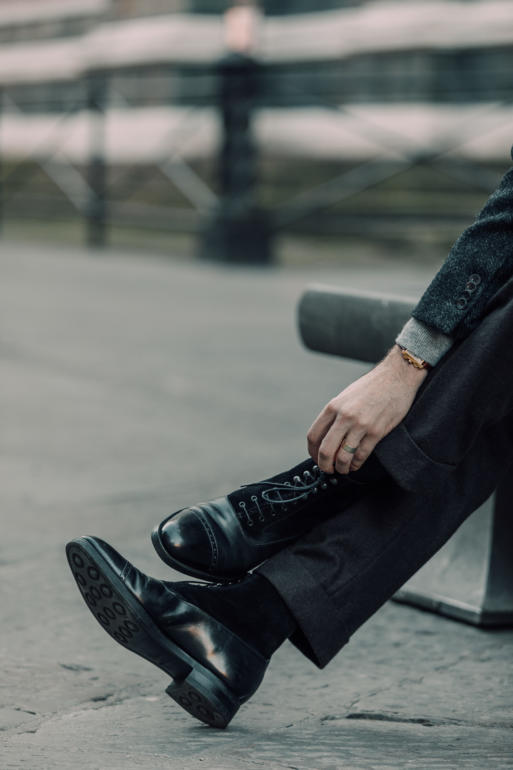
Over the past year, I’ve gradually been wearing more black.
Readers will have seen that in the recommendation of this Berg & Berg black shirt, for example, and these black cords. It's been particularly pronounced with shoes though, and I also mentioned I’d picked up some Edward Green loafers in black cordovan.
As usually happens with such tendencies, they do not occur in a vacuum. I see others wearing it, others see me, and everyone influences each other.
There are various reasons I’ve found black attractive.
One is that it is simply new, and fresh. This happens with all clothing: everything has trends. We’re just lucky in menswear that they last longer and are less fundamental.
The second reason is that it sits well with the cold, dark colours I like to wear anyway. Dark brown flannels, charcoal coats and cream knitwear make me happy. They feel stylish and refined, but not as showy as bright patterns or bold colours.
And a third reason - one that I think lies behind much of black’s general appeal - is that it has some attractive associations. Whether Johnny Cash, Parisian women, or bikers, black has historically been considered chic, young or cool.
This is particularly powerful in classic menswear, given a regular concern for many who wear it is that they might appear too traditional, old-fashioned, or simply old.
Black is also more likely to look more urban than rural - city not country.
In the traditions of classic menswear, however, black is usually frowned upon (outside of smart shoes and leather accessories).
There are good reasons for this. Black suits generally look bad - cheap and flashy - compared to the sophistication of navy.
So do black coats, with charcoal being a better choice. Knitwear too, to a lesser extent.
And while black shoes are great, they're usually prescribed for formal business clothes, not casual ones. Brown shoes are more casual and more versatile.
As for black trousers or black shirts, how do you wear them? Do they go with anything besides grey? What shoes do you wear with black trousers?
All these things remain true.
I never like to call them rules, but these customs are the foundations of dressing well, and should be learnt, practised and understood before moving onto anything else.
But having done that, it is interesting to move on - and play with exceptions and alternatives.
This is how I would categorise wearing black: as a niche, interesting exception. And one that isn’t easy to do well. Rather like high/low dressing, it requires that foundation of classic combinations to understand what works and what doesn’t.
The most important thing to understand is the ‘coldness’ of colours, mentioned earlier.
You can read the full article on warm/cold colours here, but basically cold colours have less saturation - less colour overall.
Anything without real colour is easy: grey, charcoal, white, cream, black. And then most other colours can have cold equivalents.
My dark-brown flannels shown in the top images and below, for example, are colder than most browns. Indeed, Fox calls the colour ‘char-brown’ to reflect the fact that there is so much grey/charcoal in there.
Olive green is usually colder than forest green. Dark navy is good, but not blue. Oatmeal is better tan.
These kinds of colours are the easiest to wear with black shoes or boots, as illustrated above.
In the images from Florence I’m wearing black Shannon boots from Edward Green with my char-brown trousers. And in the studio shot, my charcoal Vestrucci suit with those same boots.
And this is the biggest attraction of black for me at the moment: casual shoes such as boots or loafers in black, when a shade of brown would be more expected.
Another example is the outfit here, from the pop-up shop last January, where I was wearing dark-brown loafers but could have worn those black cordovan ones - and the effect would be pleasingly different.
Alan See from The Armoury also illustrated ways of wearing black during Pitti. He wore a charcoal coat from Liverano over grey and black on several days.
In the top image above, it’s a black roll-neck with a grey double-breasted suit, and black leather shoes. Another day it was the same roll neck over a grey checked jacket, dark indigo jeans and black boots. And in the lower image above, it's a black tie and white shirt, with black-suede loafers.
Others worth looking up are Kenji from Bryceland’s (below), who likes a black tie with his grey suits, and a black alligator belt; Oliver from Rubato, who often wears black loafers or slippers with white jeans; and Willy from The Anthology (shown lower down).
One thing these examples also make clear is that black is quite restrictive. It makes some demands on everything else in the outfit, given its tone.
And this is why it remains, for me, an exception.
I’ll still wear brown shoes far more often - but I like playing with the option of black in more casual situations than I did in the past.
Also, shoes and accessories are easy. Clothes are harder.
That black corduroy shirt of mine from Berg & Berg is great, but I can only wear it with a few pieces of clothing - such as the dark green of my Zizolfi tweed jacket, and grey trousers.
Black trousers are even harder. Worn with black shoes, there's a lot of black going on. Dark-brown suede shoes are OK, in a casual style. Perhaps Colour 8 cordovan at the outside.
But few jackets that look good with black trousers. My Berg & Berg cords have just been worn with grey or cream knitwear so far - no jackets.
Of course, you can wear black all over - as Berg & Berg creative director Andreas Larsson (below) does. But that’s more of a ‘look’ than I think most Permanent Style readers will want.
Two more things.
First, black-suede shoes belong in this category of difficulty. I have a pair and love the effect with grey suits, perhaps grey trousers (Cary Grant has a lot to answer for here). But that one piece is driving the whole rest of the outfit.
And second, skin colour has a role. Someone like Kenji, with his high contrast between skin and hair, looks particularly good in black and white.
That’s doesn’t mean others can’t wear it (as I argued in my piece on skin colour, it’s a factor, not an absolute) and Andreas or Ethan Newton do it well, despite their colouring. But it’s something to be aware of.
I would encourage PS readers to try more black. It is often in unusual touches like this that a real personal style develops.
Just approach with caution. Start with a black loafer, for example (which you might already own) with more casual combinations. Grey flannels perhaps, and a dark/cold sweater or jacket.
Find out if you like it first, before trying the full Johnny Cash. Or full Andreas.
My clothes:
- Bespoke coat in charcoal herringbone tweed from Ettore de Cesare
- Grey roll neck from Luca Faloni
- Char-brown Fox flannel trousers from Whitcomb & Shaftesbury
- Black calf/suede Shannon boots from Edward Green
- Cream watch cap from Permanent Style
- Dark brown gloves from Lavabre Cadet
Photography: of me, Jamie Ferguson; others, courtesy of The Armoury, The Anthology, Bryceland's, Milad Abedi and Berg & Berg.


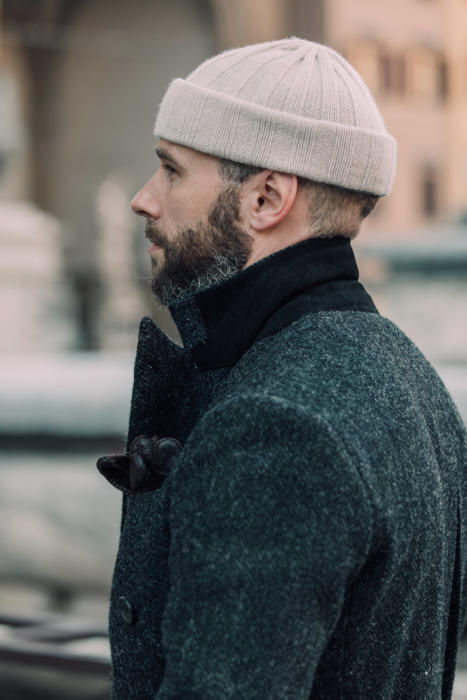
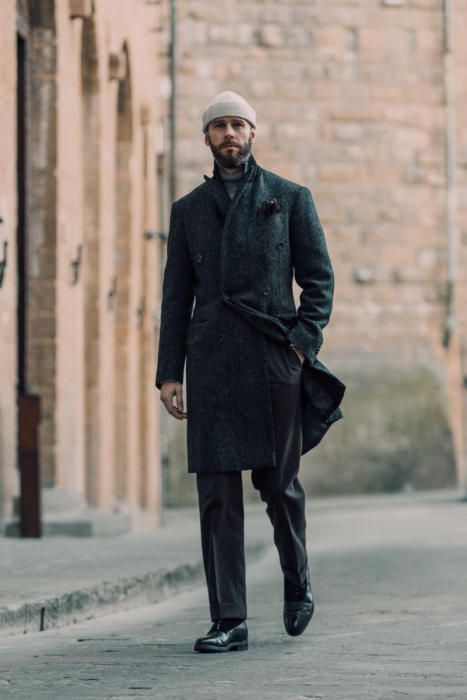
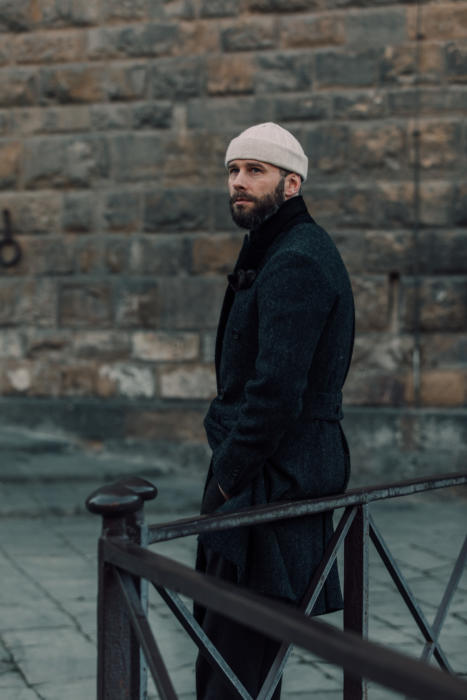
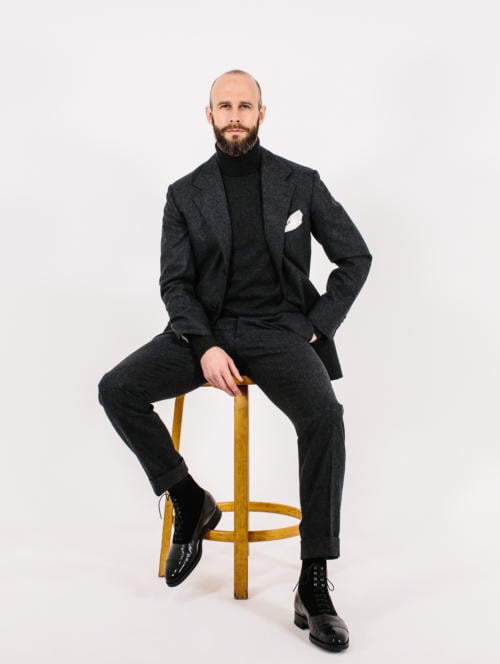
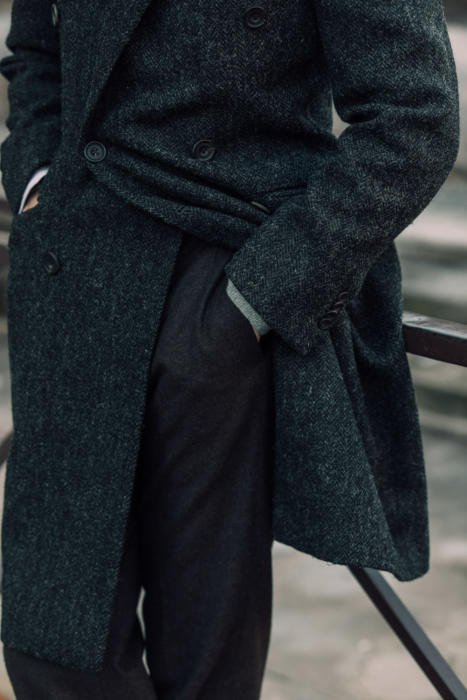
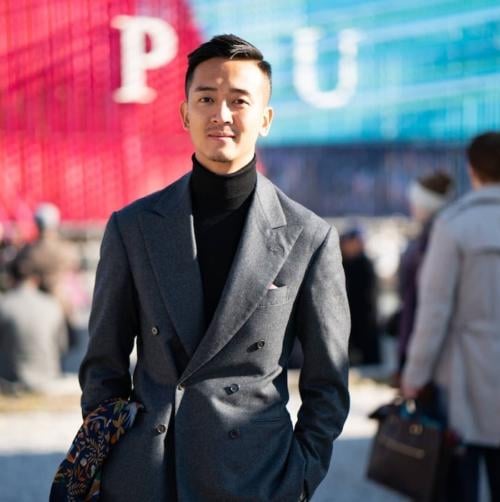
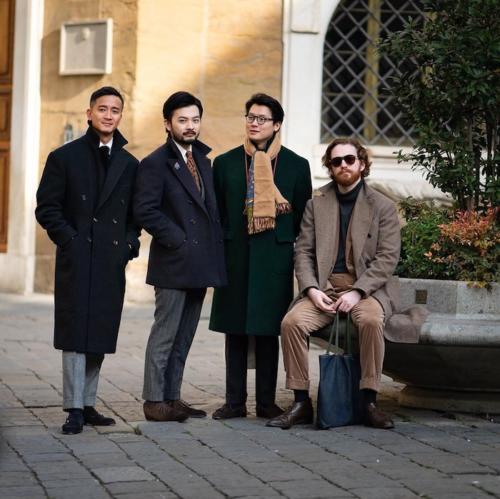
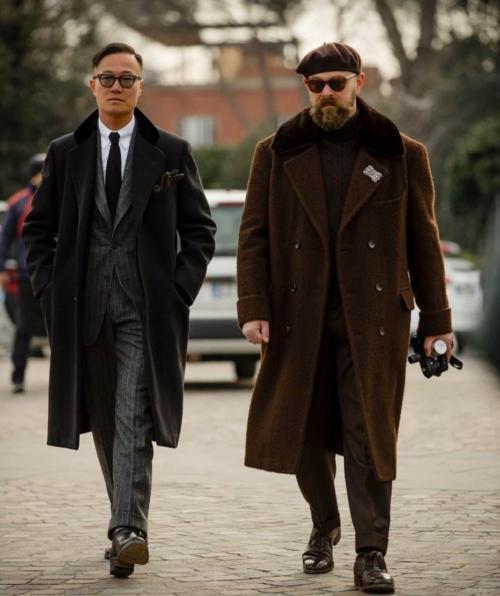
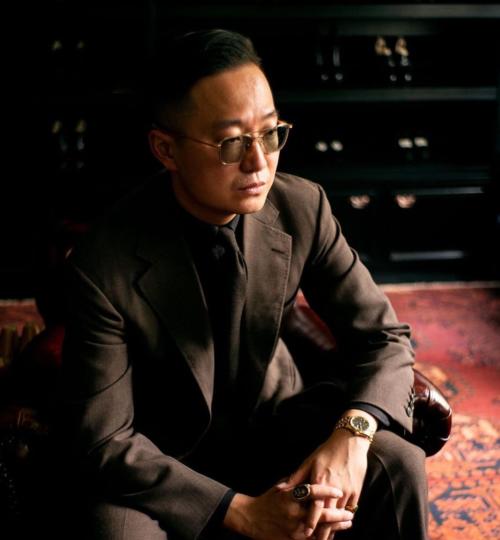
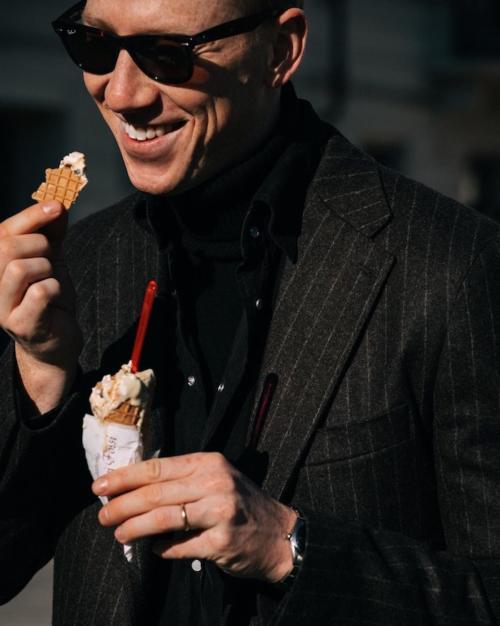
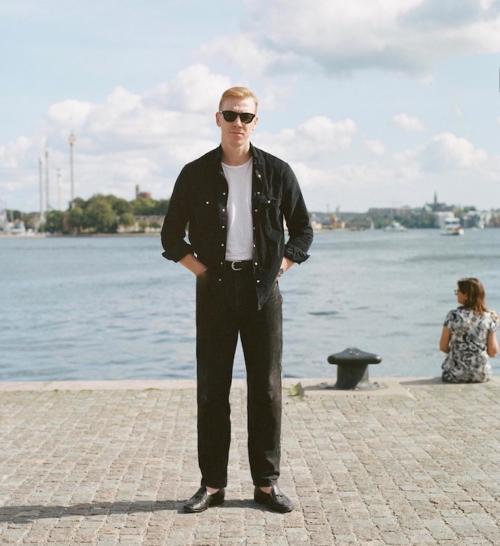
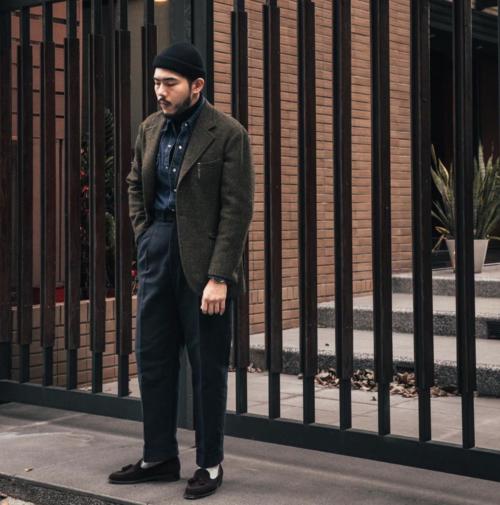
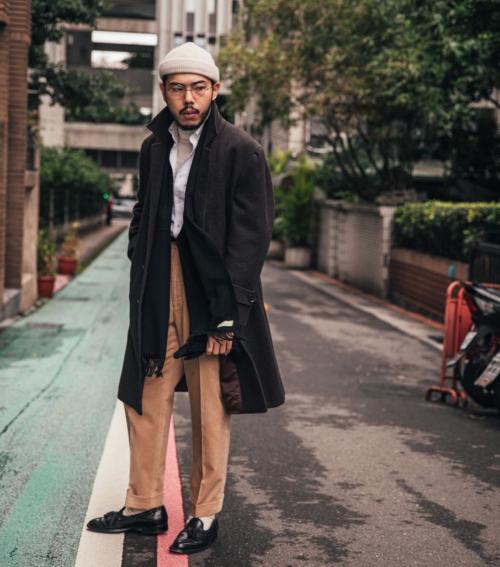
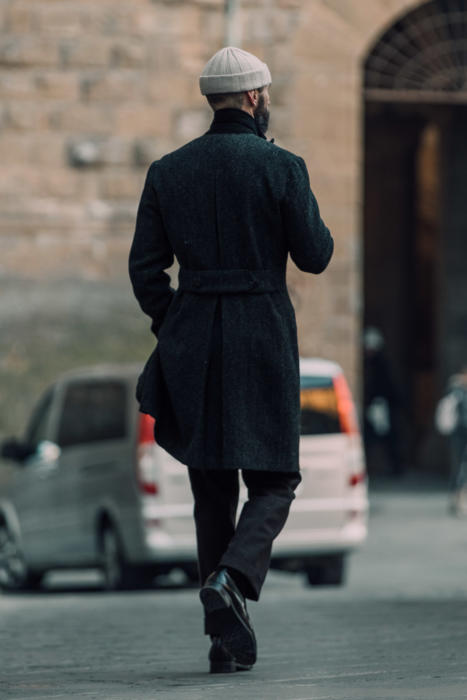
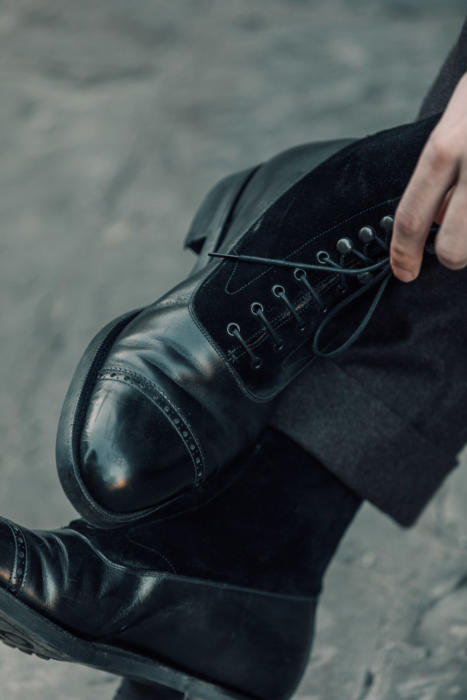


























Hi Simon.
I was wondering what your opinion about midnight blue is (especially for a suit or a blazer/sport jacket). Would you also say that this colour is also more difficult to wear versus, for example, navy blue.
Thank you.
Hey Stephen,
Personally I’d say that yes, if it’s true midnight blue and therefore largely indistinguishable from black, it would be as hard
I have a midnight blue blazer and it isn’t very versatile. I usually pair it with dark brown trousers. That works well. Mid gray works too but you look like a security guard so I avoid that combination.
I might try cream trousers with it after reading this article.
Had a flash of inspiration and am wearing the midnight blue blazer today with charcoal trousers and a dark grey merino turtleneck and black oxfords.
It looks elegant.
I’ve also been wearing more black this year, after considering it a more difficult colour to wear previously, outside of funerals and black tie.
I’d suggested/requested in your end of year survey that it would be nice to see more of other people as comparison to the style advice or style themes you were discussing in your articles. I can’t imagine a softer shift in that direction, than in this article. It’s nice to see, helpful and in this particular case I think it works really well.
Keep up the good work!
Thanks for the comment in the survey Troy, and I’m pleased you think it works well in this piece
Black was my uniform in NYC in the 1990s; it was (still is?) everyone’s then. Like short hair, I suppose, black is so much easier. Just put it on and go.
Yes, black is the standard in NYC from September to March, particularly for women. My (English) wife caused quite a stir when we lived there as she refused to conform, and regularly wore white, pink, blue etc. Some of the locals decided it would be fun to follow her lead, and all decided it was very liberating!
All black is really hard to pull off, but wander around Paris in winter and you will regularly see guys in very dark grey flannel with a black roll neck sweater and black suede shoes. And dark glasses in sunny weather. That does work.
The article a while back about wearing your Dege and Skinner brown linen suit with white shirt and black tie has been useful to me in thinking about black – the environmental conditions seem to be important. You made the point that in the harsh Naples sun with deep long shadows the high contrast look feels more germane. The more regular ‘high contrast’ scenario most of us might find ourselves in is of course under artificial light at night time, and that’s where I’ve grown fond of wearing black. A fairly obvious position to reach given the historical custom of wearing black and white at night, but a few years ago I wouldn’t have considered it in any context other than a dinner jacket. These little progressions feel significant in our slow fashion world! Thanks Simon.
Thanks Simon for another thought-provoking article.
Too many half-formed ideas to put down. But first -and I hope not reductively- it occurs to me that this may be a form of seasonal dressing: diametrically opposed to the notorious Autumn dressing; Winterreise album cover maybe. And second, it strikes me as a low-contrast, finely graduated and softly-spoken statement. Little bit of a code?
I think you’re certainly right that it’s less suited to summer, yes. Not quite sure the point you’re making with the second suggestion, but yes it certainly involves small differences in colour, though not always low contrast – eg black with light grey. It’s more the tonality and cold colours that I think defines it
On the first point: i don;t just mean “not summer”; i mean specifically Winter -spare, grey/black, bare trees, crows maybe- look at any picture of Ian Bostridge looking moody on Winterreise promotional materials- and the antithesis of the Autumn palette because those lovely red/brown/gold leaves are now dead and gone.
Not meaning to be cryptic about the second point, but most of the illustration are operating not only in monochrome but at the mid to dark end. i was thinking about rembrandt etchings and the way the modulations of darkness draw your eye in. (granted that it’s light on the left of the picture, but i always look right)
http://www.rembrandtpainting.net/rmbrdnt_selected_etchings/recent/rembrandtchristbisbis.jpg
Simon, what do you think about black denim jeans? Been eyeing some by Blackhorse…
I’ve never had any. I think they might not be great with the other casual things I wear, but haven’t tried so couldn’t say for sure.
I’ve been a fan of black jeans for a long time.
Black jeans, chestnut/espresso suede shoes, white OCBD, charcoal sweater.
Black jeans, chestnut/espresso suede shoes, pale blue or white OCBD, rust/sage/moss tweed.
Black jeans, black suede BC’s, black rollneck.
And so on.
As ever, don’t overthink things.
I think black Jean’s, if they’re actually denim, will look more like charcoal as you tend to have some white showing through. If not right away, then before long.
Good point
I think during the Pommella talk with Simon and Douglas Cordeaux! I believe it was Douglas who made the statement that if you can get anything vintage in Black it is well worthwhile as the black newly created is not a true black as they are not allowed to use those dyes anymore. There is a video recording the talk in this websites previous posts.
It’s here Ian.
I’ve got a pair, and I would not recommend them. Basically, they go only with certain pieces, and mostly casual one. White tshirts, grey and oatmeal sweaters, white sneakers. Easier in winter, thanks to charcoal and camel coats. Black boots as well, of course. Dressing them up is easy, but it’s one way only – white shirt, black shoes, maybe grey cotton jacket. Go for them only if you have many other options, because they don’t offer much
An interesting article. Here in Toronto black has been a mainstay of urbanites for 30 years……almost a throwback to the “hip” generation of the late 50’s. And early 60’s. We hardly consider ourselves fashion trendsetters here in “the great white North” but it appears we might be. I myself have a black linen suit and a soft flannel suit which I reserve for funerals ( choice depending on the season) but have always considered them too severe for everyday wear….almost like “mafioso” cosplay. I also have a black wool/cashmere pea coat and several both black cotton and wool trousers. Perhaps I will now give them more “air time”.
When you say, “oatmeal is better tan” do you mean oatmeal is a better version of tan or that oatmeal would be better if it were tan (in this situation)
It should read ‘oatmeal is better than tan’. Sorry. As in, it’s a better choice among light browns
Simon, could you please explain the difference between tan, oatmeal, cream and beige? I’m not actually sure which of those are used here interchangeably…
Unfortunately I don’t think they’re used that consistently. Perhaps a post giving fairly standard examples would be helpful.
But at the very least, cream is almost white, tan is the strongest colour (more orange/yellow) and beige and oatmeal are somewhere in between, with oatmeal closest to cream. Of those, tan and beige seem to be the ones defined most variably
Hi Simon, thank you for you article. I would really like to wear black jeans (perhaps washed so more grey-black) with a jacket but have been struggling, as you mention, to think of a suitable paring of jacket. I was thinking that perhaps marling and Evans PoW tweed or one of the recent fox PoW tweeds in grey/black/cream whatever they are would be an option, what do you think?
Yes, that might work. The whole thing might look a little monotone and severe though. Dark, cold versions of other colours might be better – like the Zizolfi tweed I linked to.
In the end, most of the time dark indigo jeans are going to be more flattering and easier to wear with other colours
I wonder whether it’s easier to wear black clothing that has a prominent texture (e.g. your corduroy trousers/shirt and suede boots).
One of the problems with black is that it can look flat and texture helps avoid that.
You might be right Winot, I hadn’t thought of that. Black shirts and black jeans have a similar issue until they start to fade and go grey in places
Hi Simon, I think black mostly works when the texture brings a subtlety, making it lean towards a dusty charcoal. I notice that your two recent acquisitions from Berg&Berg are corduroy. Linen might be put in this category as well.
black definitely adds an edge and youth to any appearance. Its a good recommendation to experiment with the colour; and It’s not incredibly difficult to pull off. just wrap a black scarf around any of the models in the photos above and you can see their image transform. Black + charcoal and black+ tan (both seen above) are really cool combos.
Great article Simon, I’ve had a black and grey check wool blazer for some time but find it very difficult to pair with anything other than grey. What color trousers would you go for when wearing a dark grey blazer?
I’d suggest trying any of the cold colours I mention above – dark brown, dark olive green, beige, cream. And indeed navy, as discussed here. Hopefully the check will mean there is enough contrast between jacket and trouser, even if the jacket is dark.
There are warm blacks that go with other warm colors
Thanks. Do you have an example we could see by any chance?
Add red to black to warm it…my Italian fabric trousers are warm black
Thank you
Again, you are confusing saturation and hue. (Wikipedia has an article on color theory that explains the difference between these two terms and between warm and cool colors). Coolness and warmth of colors is a property of hue, not saturation. Blue, for instance, is the coolest of the cool colors and can be very saturated. I don’t say this to be pedantic. I say this for several reasons.
1) The terms ‘cool colors’ and ‘warm colors’ have very standard meanings that are quite different from the way you are using them (I haven’t seen anyone else use these words the way you are using them). Using these words in other ways can genuinely confusing.
2) These terms capture important differences that are useful in explaining meaningful differences. For example, whether a color goes with black is mostly a matter of saturation (whether something is colorful or more grey/black/white), but hue (this is where coolness and warmth come into play), and value (how dark or light something is) also probably play a role. Any theory of what goes with black will be incomplete if only one of these factors is considered.
Thanks EL.
So when I say the colour is more saturated, I mean hue. Got it.
On point 2, I also see how all three things are all important, though I’d say dark v light is less important. Certainly it feel less to me.
On point 1, the way I’m using the phrases feels intuitive to me and it seems to communicate with others. I’m not sure anyone else has said it’s confusing.
If I change the word ‘saturation’ for ‘hue’, how is the way I’m using the words confusing? I’d like to understand
Thanks a lot
“So when I say the colour is more saturated, I mean hue. Got it.”
-The issue is that you take cold and warm to mean something different than what these words normally mean. One of the ideas in this article is that black goes with things that are less saturated. The problem is, instead of saying “less saturated” you say “cold”. The coldness of a color has nothing to do with how saturated a color is. Coldness is a matter of how blue a color is; warmness is a matter of how red a color is. You are basically talking about how grey/white/black things are, though.
“On point 2, I also see how all three things are all important, though I’d say dark v light is less important. Certainly it feel less to me.”
-I agree. Saturation by far seems to be the most important. Value (how dark or light something is) does seem to be important, though. Most outfits you have pictures of above have only very limited amounts of whites, light greys, and creams.
“On point 1, the way I’m using the phrases feels intuitive to me and it seems to communicate with others. I’m not sure anyone else has said it’s confusing.”
-It makes sense to you because you are expressing the right idea, but with the wrong words.
-They may not realize it is confusing, especially if they are unfamiliar with the distinction, but it certainly can lead to confusion. For instance, if another clothing site were to use these words in their normal senses and someone were to read both that could lead to confusion or at least hinder understanding.
-The other problem I mentioned before is that using ‘cool’ and ‘warm’ as you are using them, may lead people to overlook other important aspects of color.
“If I change the word ‘saturation’ for ‘hue’, how is the way I’m using the words confusing? I’d like to understand”
-The main problem is your use of ‘warm’ and ‘cool’. The main point in the above article actually has nothing to with warm and cool colors (at least as far as I can tell). ‘Cool’ is basically how blue a color is and ‘warm’ is basically how red a color is. Your main point, though, is that black goes best with very low saturation colors like grey, white, and cream. These colors need not be warm or cool.
Again, if any of this is confusing (as it is to most people when they first learn about these things) the Wikipedia article I mentioned before lays out things pretty clearly.
Thank you EL, that’s helpful.
You’re right, I mostly mean a lack of saturation, but also (perhaps less so) how cold (and as you say, therefore blue) the colour is too.
Separating the two seems the hardest aspect to show and explain.
I also think there’s an extent to which colours with less saturation usually feel colder, perhaps in a more intuitive, physical way. And given those words are obviously normally used to mean something different (actual temperature) they must be the hardest ones to tie down to a particular definition?
Etymologically, warm/cold colors may have been first uttered in descriptions of landscapes in daylight vs. night. This is consistent with your intuition that black trends cold. But modern color theory indeed uses the terms to describe different hues, with red/orange/yellow near the “warm” pole and blue/green/purple the “cold.”
No simple theory using any of these concepts—saturation, value, hue—perfectly describes my preferred pairing with black. Generally, I strongly prefer colors of both moderate to high value and saturation next to black: oxblood, copper, forest or olive green (the forest green coat in the Alan See picture works well with the very dark trousers), aubergine, navy. I can’t imagine most pastels working with black. But then white, beige and camel are all great. None of this makes black suits easier to wear with non-whites, though there’s a recent black tie trend of wearing bold velvet jackets over black trousers that illustrates my preferences pretty well.
This is just my personal view too, of course, but the way warm/cold has been used on PS has always seemed intuitive to me. All you need is a couple of examples, as there were in the original post, and say that one’s warm, that cold, and it immediately makes sense.
I find EL’s information very interesting, but perhaps too technical and a little confusing. There’s no need to get into colour theory, and separate hue and saturation, if simple descriptions such as those on that post make sense. Equally ‘value’ – just say darker or lighter. Even if it’s less technically accurate, it doesn’t matter, as the point has been communicated (at the level required for the point) effectively.
Also, I think the way a lot of people are used to describing colour comes through editing photos these days – on their phone for example. And the way saturation and warmth are used in these posts is as how I experience them from that editing. I can give a photo more saturation, I can adjust the temperature, and I get the effects Simon is describing.
Again, great discussion.
Personally, I’ve found the usage of warm/cool on this blog confusing, and I’m finding EL’s definitions much more intuitive. I don’t want to say your usage is wrong, Simon–I’m sure you picked it up from somewhere and it may well be the standard in certain quarters. From my background (some formal training in physics, as well as some knowledge of computer image processing), EL’s definitions are more in line with what I know.
I agree with this and have found “warm” and “cool” confusing in this article, but I also come from an art background with an education in colour theory. But these things do not come in absolutes. Some say red is the warmest and purple is the coolest, based on wavelengths in the colour spectrum. Then others place orange as the warmest and blue as the coolest. Warm and cool colours are all relative (some blues are cooler or warmer than other blues), but most importantly they are based on hues and not on saturation, as the terms warm and cool are used here.
In menswear, earth tones like brown and olive are warm and city colours like black, grey and blue are cool.
For example, olive green is *always* warmer than forest green. Olive is a shade of yellow on the spectrum, making it a warmer colour forest green, which is a blue-green.
Above the difference between terminology and colloquial speech is naively taken for granted, and
use of the generic “color theory” obscures the fact of color theories, as philosophy philosophies. Here as moderator is needed somebody like Ingo Nussbaumer, who reproduced every Goethean color experiment and without polemic compared Goethe with Newton.
Maybe the trend to more black is a reflection of the public mood? Do we wear more black when the mood is subdued and brighter colours are more prevalent when the public mood is confident and forward looking?
This article has me considering a black scarf with my light grey pea coat.
I’ve always liked black, but agree that it’s hard to wear well and requires thought and attention to detail to pull it off. I have a beautiful herringbone grey cashmere jacket with flecks of white in it that I think would look good with black flannel pants, but am concerned that there may not be enough contrast. I have a pair of lighter grey flannel pants, with black mixed in, that definitely provides more contrast, but it’s an entirely different look. What would you recommend Simon?
Black will probably produce enough contrast, but the other dark colours mentioned here (see comment above too) would probably be easier?
Black is the international hairdresser’s go to colour 24/7 52 weeks of the year.
It’s also big with funeral directors !
Approach with caution would be my advice to any self respecting flaneurs.
Hi Simon,
When I was younger and more adventurous, or shall we say rebellious against the style of my Father and Grandfather…..I would on occasion wear a black spear point, French cuffed dress shirt with either one of my powder or even sandy warm pale gray suits, or with an olive suit, or particularly often, with a rich chocolatey brown or charcoal brown suit, though I preferred the contrast of the chocolate brown against the black, more.
I have also worn black semi brogues with a chocolate brown suit, an ecru shirt, and a maroon tie with an ecru silk pocket handkerchief, which looked handsome. My hosiery with that was burgundy. There are many ways to play with such combinations.
With the pale sandy warm gray suit, a woolen sharkskin, I wore sometimes a black shirt with a deep maroon tie with cream figures, or a tarnished silver grenadine tie, almost a champagne. I also used to wear tan semi brogues with a pale cool gray suit, and a black shirt and hosiery with various ties. I suppose that I had a “black” garment phase, though I have since, largely left that behind me. I grew tired of so much black, though I did learn how to play with it, which is very useful. I have also worn a black tropical weight stiff wool Brooks Brothers sack suit from the 1960s, with a dark mahogany brown alligator skin belt, and chocolate brown suede wingtips, a white shirt, and a muted brown ancient madder tie with figures in olive and rust and yellow with blue. It looked very eclectic and interesting.
I’ve been experimenting with black for the past few years, largely because after some years of eschewing all black I started to miss it. I’ve found that with cloth, it’s a bit easier to wear black that has texture (cord, knits, flannel, etc.) – hard black worsted can be tricky.
When picking an outfit, I often think quickly what elements should be the foreground, middleground, and background. For example with shoes: if I wear a striking pair of burgundy G&Gs, those shoes will catch the eye and will become part of the foreground. Dark brown shoes tend to be part of the middleground – not the first thing noticed, but definitely have visual interest. However if I wear black oxfords with charcoal trousers, I feel like the shoes immediately become a background element, allowing other parts of the outfit to stand out more.
For me at least, that’s how I tend to use black: to create background elements, as there is little there to catch the eye, and I don’t personally want every part of my outfit to stand out as a foreground element. You don’t have to use black for this of course – low-contrast elements can also be used to push parts of an outfit to the back of the middleground, Also worth noting that black can be used to the opposite effect, to create contrast. The most obvious example is black tie, the way a black satin bowtie pops against a crisp white shirt.
Hi Simon
Interesting article, certainly outside of shoes and belts black is a colour I have rarely considered. Good to hear your perspective.
Perhaps a personal question, but I was intrigued about your description of how some clothes make you feel “happy”. Certainly I can relate to feeling confident when dressed a particular way but I have never considered an emotion such as happiness. Perhaps you could expand on what you mean by happy and why is it that drives that feeling.
Nice point Richard.
I guess clothes I like give me a sense of pleasure as well as just confidence. That comes from several areas, including putting up an old favourite that has worn in well and feels like a friend, seeing how something fits perfectly and compliments me as a result, and the combination of colours and textures in a pleasing way. They give pleasure and make me happy as a result. The latter is perhaps akin to the creative experience – seeing art, listening to music, even interior decor that feels pleasingly put together.
Hi Simon
That makes a lot of sense. After a hard day, the comfort and relaxing effect of swapping a suit jacket for a nice cardigan. Yes, happy is a good word.
Very interesting photos, especially the surprising combination worn by the man standing in front of an iron gate. But in the picture below isn’t he wearing rather warm beige trousers with an otherwise completely cold outfit? And wouldn´t dark brown shoes have softened this clash of temperatures.
Hey Martin,
Yes perhaps. The brown coat and cream roll neck help a little, but perhaps a colder shade of trouser would have been slightly better
For me black comes into its own as a roll neck sweater. In my opinion the most versatile item of winter clothing. Cashmere for colder days and merino in milder weather. I find it really ‘centres’ an outfit and in my opinion works with most other colours form tonal (eg dark grey) through oatmeal, and have to say tan in a jacket with texture, to sharper contrasts (although not on me for the latter) and of course indigo jeans. Therefore recommend trying the roll neck as good place to start, or a quarter zip, button neck sweater or a long sleeve merino polo. I. The summer a black short sleeve polo.
But beyond that I tend find black a bit harsh and with hint of ‘uniform’ for other items of clothing, except a traditional overcoat. The Crombie with a red lining and velvet collar (from Crombie) , served me very well as a investment pice through many years in a more formal environment.
Thanks again Simon for another article that provides guidance and ideas.
‘Au contraire mon frere’ : )
I cant help but think you are correct in your initial assessment that black is for johhny cash, parisian women and bikers (and i would add newly transplanted new yorkers trying too hard)!
Call me a traditionalist but again i concur with your thoughts that it is best left for formal wear.
Besides the fact that so many people think that by simply wearing black they are ‘slimming’ their appearance or being ‘hip’ it smacks of laziness due in part to the old adage that says, ‘dont worry everything goes with black’?!? It doesnt and shouldnt.
Your herringbone tweed coat is magnificent!
Visit the cities of German dialect speaking Switzerland and see which colour for clothes predominates. In German Switzerland it is very important NOT to wear a colour which would attract attention. Since everybody is busy wearing that same colour, everybody feels comfortable. Swiss Germans, especially men, do NOT want to attract attention.
See the colour chosen by non-Swiss tens of thousands of lower and lower middle class foreigners employed in Switzerland.
Check which colour shirt, trousers, jacket is worn by any architect in German Switzerland.
Ex-Queen Mother of Darkness whistleblower Jessie Czetobar explained why witches wear black,
Sadguru has his view of the quality of wearing black that it absorbs the surroundings.
Simon
I’ve always enjoyed putting black and brown together, I would think you would have tried that as well. I’m certain you would do a lovely job of it.
Thanks Robert. Yes absolutely – hence the brown flannels here with the black shoes, and mention of brown suede loafers with the black trousers.
Or did you mean brown in another part of the outfit?
“And second, skin colour has a role. Someone like Kenji, with his high contrast between skin and hair, looks particularly good in black and white.”
Spot on. Here in Mongolia I often covet the clothes of friends who look great in black and white, even though I’m certain that everything they wear is around H&M level and their entire outfit cost about the same as a pair of your socks. Unfortunately for me those outfits only work because they’re accessorised with jet black hair and Asian skin. Whenever I try to wear black – with my greying brown hair and a skin tone that ranges from pale and pink to sunburned and pink, with the occasional drunk and pink – I look like a rejected extra from The Matrix.
When it comes to shoes, though, I just can’t get on board with black. I have a couple of pairs just to fill out the wardrobe, cap toe Oxfords from Carlos Santos and a semi-brogued Oxford from Church’s, but whenever I wear them I always look down at my feet and just think “Oh. There they are. Shoes. On my feet.” I have almost identical Santos Oxfords in brown with a beautiful rich patina, and if I’m not careful I’ll get distracted by them and wander into traffic. The black shoes only see action when I’m dusting them.
Black shirts in Italy are are a no no.
Not just in Italy.
I’m based in the UK and, for me, a ‘black shirt’ has some fairly unattractive connotations: priests, faschists and untrustworthy slimeballs (covering a wide spectrum of misdemeanours).
Fine in cord or denim though and there is definitely a place for black in a man’s life.
Hi Simon,
I was interested to see this just after reading a piece ( a few months old) on wearing black on Styleforum. I notice both you and they did not discuss the black odd jacket at all, even though they did mention black suits.. Is this garment truly beyond the pale?
It’s pretty hard to wear well Ian I think, yes. Unless it’s something rather formal and old-fashioned, like a stroller with grey trousers, white shirt and dressy silk tie
Thanks for the reply Simon, I had forgotten about the stroller.
I have such a jacket-bought in a sale and on a whim-but it is in a spongy soft cotton, like a more velvet-y moleskin, and too casual to carry off the stroller look completely. It is the jacket my wife likes most, however, so I try to make it work!
I usually wear it with grey trousers or jeans and keep it for night-time socialising mostly, which is why it is interesting to read your thoughts on wearing black casually. I find it hard to pick any shirt colour other than white with this though, but a happy wife is more valuable than an impeccable fit.
It’s hard to say remotely of course, but I feel those grey trousers and very dark-brown shoes might be nice, and perhaps a pale blue shirt – or even pale pink?
I will try the pink shirt and brown shoes; to be honest I didn’t even consider using non-black shoes with them! Pale pink, given how good pink shirts look with grey suits, should be ideal.
I have tried it with the blue shirt/grey trousers combo but an alarm goes off in my head telling me to wear a navy jacket instead.
Depends where you work/mix, Simon.
A black odd jacket will find a natural fit with a black T shirt and white jeans.
Pleased I described that well. Happiness would be a nice thing to aim for as well as confidence. Same with food, books, film and many other things.
Simon, I have debated for days whether to engage this particular point, but I have decided to take the plunge: I am a little miffed (for want of a better word) by your statement “This is particularly powerful in classic menswear, given a regular concern for many who wear it is that they might appear too traditional, old-fashioned, or simply old. ” In the first place I fail to see what is wrong with tradition, and furthermore, most well-dressed men tend to be middle-aged or older because it takes time to learn how to dress well, just like it takes time to learn how to do anything well. Finally, as has been discussed before on this and other blogs, one of the secrets to elegance is being confident in one’s own skin. I fail to see how constantly worrying about appearing old-fashioned (again, what’s wrong with that?) could possibly be conducive to dressing with confidence. Granted that fewer and fewer men understand and appreciate classic menswear, still those of us who do should wear our herringbone sport coats with elbow patches, our DB blazers with brass buttons, and our Chesterfield overcoats with confidence and panache, or not wear them at all.
Thanks for raising it Daniel. I don’t think men should necessarily worry about appearing old-fashioned, or traditional, I just think a lot do.
As a purely personal point, I’m also always particularly interested in adapting some of these traditions, just for how I like to wear them, because I do think it would give them broader appeal. You can absolutely wear what you like, and I’m sure you look great. But one way to get men to understand its appeal is to bridge the divide a little.
I hope that makes sense.
obviously there is a spectrum here, and a balance to be struck. where do you draw the line? I am sure you don’t still wear a ruff out and about do you! 😛
nice article simon. what do you think about black socks?
I’d only wear them with black trousers.
Wear navy socks with navy trousers, grey with grey. Socks show you care – post on that here. (From 12 years ago!)
thank you. i received some black socks as a present last year but never wore them as i find them too harsh to combine with anything not black
Simon,
I am reminded of a nice post that you did some years ago on the virtues of a solid black necktie, especially with some texture (i.e., grenadine).
Cheers,
Nick
Thanks Simon for the interesting article. Before I started reading your blog black was my go to colour for dressing up (never owned a black suit) I feel that I since evolved but have a long way to go. The one thing I still like is a velvet smoking jacket and a black turtle neck – I guess its as you say ‘ a look’…
It cracks me up to see the classic menswear crowd “discovering” black. I’ve been completely flummoxed by all the articles in the last several years prescribing Byzantine rules for how to wear it, or more often, banishing it altogether.
Here in New York City, over the last 60 years or so, black has practically been the uniform among whole cadres of artists, designers, architects, composers, rock & rollers, and other who look effortlessly good while being cooler than any #menswear pundits who’d glare at them.
These groups fall back on black for all kinds of reasons, but high on the list are 1: it looks good, 2: it’s cool, and 3: it’s easy.
I mean, come on. Black literally goes with everything. I concede that not all black clothes look good in all contexts. A black suit is hard to pull off and probably not worth it, and black overcoats are mostly good for displaying cat hair. And yes, you need dark shoes with black pants, and people with low-contrast complexions should avoid black and white. But beyond that … relax. Get down with your bad self, put on some black, flip off a pundit, go downtown, and look good.
“…black overcoats are mostly good for displaying cat hair…”
Thanks for supplying my morning chuckle!
In my youth everyone who thought of themselves as cool and rebellious wore black. So I came up with this slogan – Black, the official colour of non conformity.
Perhaps because it was so restricted to evening wear before sixties? I don’t know, I’m not that old. The fun thing is, it might genuinely have been the colour of nonconformism. But since everybody is wearing it, everything is in reverse now. So is NOT wearing black the new black?
Last week I wore my black mid calf length cashmere overcoat purchased 15 years ago and people, mainly women, loved it. All kinds of comments, mostly very complimentary, were made about the coat and how more men should wear overcoats etc. Of course there’s always one or two, always men, who say something inane like “ you look like Neo in the Matrix”, but I just ignore them. Guys, a long black overcoat will get you noticed in a positive way. Black still works extremely well when worn correctly.
Regarding black jeans: almost all of them have black warp and black weft, so they read as true black. When worn in, they turn gray and have a completely different feel.
Black jeans are one of the easiest things in the world to wear. You can wear them to work, then to a punk rock show or to the opera. To be versatile they have to be newish and have to fit very well, and you have to choose your shoes and top well. They go with chelsea boots, chunky derbies, pretty much any kind of boot, dressed-up-or-down sneakers. On top, if you wear anything tailored, some fabrics work much better than others.
Black jeans used to be part of my uniform, but these days I only wear them occasionally, partly because I’ve discovered raw indigo denim and find it more interesting.
Interesting discussion. You’re quite influential, so your views may likely have some impact on a higher acceptance of black menswear. I must confess, it can look very sleek in some seasons and/or weather and occasions as long as it’s not overdone.
I’m not quite on board with Simon on this one. And no for ideological reasons – hearing the iGent purists claim that black is for formal evening events is hilarious. I actually have a few black things, mostly from my metalhead years. But the thing is, the more I learn about clothing, the less use I get from them. Compared to navy, charcoal and charred dark brown, black is much less versatile in mixing with other colors. So the question remains – with what can you even wear it? It seems that it’s mostly more black, charcoal, then other greys, pale browns, sometimes navy. Maybe olive greens and burgundys, but it’s a case-by-case scenario. Here’s my input, mostly from experimenting with what I have:
– Black shoes and boots – those are easy and obvious… black, navy, grey pants and suits. Black chelsea boots are underrated, they can work well with jeans as well. Brown does not seem to work here, but maybe pale charred brown or cream…
– Trousers – black chinos look cheap, in my opinion at least. Jeans are somewhat better, but still not great – pale brown and gray sweaters, white shirts, maybe a grey cotton or flannel jacket?
– Knitwear – turtleneck seems to be the best choice, since the other ones contrast with shirt either too much (white) or in an ugly way (blue and so on). Works under gray/charcoal jackets, suits and coats, camel coat is ok as well. I had some success pairing it with navy jacket and peacoat.
– Blazer – I’d say no. Only works with grey trousers, and makes pretty much all neckties look cheap. I have no idea how men could look good in Victorian full dress.
– Outerwear – the classic black leather jacket seems to only work with grey trousers and jeans, white/grey shirts/tshirts knitwear…. Coats aren’t much better. I know, it looks great with gray 3-piece and a black necktie…. But with what else?
Of course everything here is completely subjective and based on my own sense of aesthetics. I’m not a radical dandy by any means. But why would I go with the black turtleneck, when I could go with dark brown, which works with so many thins, over a black one, which works with three, tops? Same thing with black and indigo jeans, brown and black leather jacket… All in all, it seems okay when you already have a large wardrobe and can afford some pieces that are so limited in versatility. Otherwise, I would skip it. Unless it’s for evening wear…. but how do you approach evening wear with casual and smart casual outfits? I’d love a post about that 🙂
@ PETER K … “In my youth everyone who thought of themselves as cool and rebellious wore black. So I came up with this slogan – Black, the official colour of non conformity.”
This is funny; I used to think the same kind of thing whenever I saw a rebel group with a strict dress code (Harley riders, 1970s punks, goths, Deadheads, etc.). But I’ve since realized what should have been obvious, which is that non-conformity isn’t a declaration of uniqueness—it’s a declaration of allegiance to some or other subculture. It’s “I’m not one of you corporate wankers, I’m one of us death metal wankers!”
The declarations of individuality are more subtle … they happen in the little ways you differentiate yourself from other tribe members. You wear a different shade of black laces in your oxfords; I put a subtle fringe of crimson in my mohawk.
I recommend starting with a black roll-neck sweater. It pairs equally well with jeans or grey flannels.
Love this kind of article and heartily agree with the other commenter that I’d love to see more like it! It’s also very timely as I’ve just been in Copenhagen for a week and noticed how many men there wear black really well. Albeit in slightly more casual ensembles than you’d normally find on PS.
However, some of my favorite outfits were those that paired mostly black background with one item in what I would consider a very saturated color such as a tan overcoat, a burgundy sweater, or a moss green shirt (I think this is the point Ben is making too). I guess this sounds kind of at odds with your idea that black works best with colder colors (or less-saturated, as some have pointed out is more correct) so was wondering what your perspective is on strong, darker colors with black. Best with more casual outfits, or could it work with smarter combinations too?
Personally, I think best more casual.
Though as always, the point with the colder colours is that they’re easiest and safest, not that they’re the only thing that can work.
With the strong colours you’re talking about, darkness would certainly help
I really found your article interesting , however there was no mention on the color of the socks .
I seem to recall the rule that the socks should always match the color of pants . How has that changed? Or was there ever such a “ rule “?
It is mentioned above in the comments.
Matching the trousers is the convention, yes, as it extends the line of the leg. And I’d generally avoid black socks for that reason, particularly as they suggest the man that just wears black socks because it feels like they go with everything – but actually complement nothing
On related topic, which socks would you choose for cream, olive and dark brown trousers? Especially dark brown is puzzling for me – it has the added problem of shoe color
I’d pick matching socks as my default with all three…
After that, I’d wear olive green with most, as I like how it combines with everything else.
And if you feel odd wearing such light coloured socks with the cream trousers, then go for something just a little darker, like beige
If you’ve got the b*lls to wear them, there is one colour for socks which will match anything you will ever wear.
Cardinal Red
Thanks! But how do you avoid dark brown trousers, socks and shoes blending together?
Try to have some contrast between shoe and trouser, for example a shiny calf shoe against a.matte flannel trouser. Or a shoe with different browns in there – a lighter body but a dark for for instance.
I should have mentioned that I get my Cardinal Red socks from Gammarelli (suppliers to the Vatican), through MCR.
It’s funny how wearing black for us “sartorialists” appears to be a bold move, while the average person on the street would consider a higher amount of black in an outfit a return to normality. I chuckled when Hugo Jacomet told the story of Lorenzo Cifonelli almost fainting when he came up with the idea of commissioning a black suit.
Coming from a subcultural background, where the only differences in my outfits used to be different metal album covers on an otherwise black canvas, I personally don’t see myself incorporating too much black into my outfits any time soon, but your thoughts on this topic are highly refreshing, Simon. Greetings from Germany.
Very intersting article simon,bravo.
My opinion is the black colour in formal dress is restrict white,grey,cream.I find very interesting the combination black ,navy can i wear black suede jasket with navy trouser or the same jacket with brown chino trouser and brown suede shoes ? Thank you
Nice Article Buddy
Not related to this post but perhaps you can help.
I’m ordering trousers and one of the fabrics I have in mind is one you suggest is very versatile. It’s the putty color cavalry twill by E Thomas…articolo 1311/164 in your post.. I’d like to get a swatch, the distributor in NY does not have it. Sent a Email today to E Thomas requesting a swatch stating I know it has to be ordered by the tailor.
Any further help you can offer to obtain a swatch of this fabric?
No, sorry. You’re unlikely to have much luck with the mill as well – if they’re not a merchant/agent, they’re not set up to send swatches. They may not even have any – it’s woven to order for the merchants, who sell the cut lengths
I am thinking of buying my first pair of black loafers. I think that i will mostly wear it with a monochrome outfit (think mid-grey trousers and charcoal sport coat). But I am thinking of having the loafers in grain to add some interest. (Plain black loafers is unfortunately associated with midwestern congressmen with oversized blazers). Do you have an opinion on black grain loafers vs plain calf or suede?
If you don’t have a pair already, I’d go for calf over suede. On grain, I’m not sure to be honest, I’ve never tried it. My instinct would still be to go with calf, but I’m not 100%. Cordovan might look a touch more casual too?
What is your opinion on lama calf or arlington compared to plain calf?
Lama I have seen and it’s a nice version of a grain, but I’m not a big fan of grain leathers – better on more casual, country shoes either way. I’m not sure about Arlington – could you send me a link?
Sure, here you can see Arlington Calf:
https://stefanobemer.com/products/t6451-black-arlington-s-last
which i am thinking for this loafers (here in Lama Calf):
https://stefanobemer.com/products/tassel-loafer-with-apron-c1327clamablck
Thanks. Of the two, at least as shown here, I’d go for the Lama as it’s more subtle – nice subtle texture rather than something more obvious
Thank you Simon.
I also tend more to the Lama texture, though i don´t know if i am going to like its softness which i suppose this leather has because of the hard tumbling and i am also not sure how hard wearing it is compared to other calfs.
Do you think it is a good choice to dress it both casual (separates) and even more casual with cold coloured denims and summer trousers with t-shirts?
You say you would rather go for plain calfs for black loafers, can you give some examples / which ones you favour?
I think the style of the loafer might be a little tough with the more casual things – the longer last, the slimmer lines. It’s really a dress style. That’ll make more of a difference than the leather
Ok, got that!
Many thanks Simon.
Hi Carl,
have you finally tried out the grain, did it work for you?
Got it, and thanks for your response. FYI, if Fox Brothers has any of the ecrue cavalry twill available, I instructed my tailor for trousers to order and move forward. H&S have a location in midtown NYC and knowing they do not sell retail they welcomed me to visit and review their fabrics in the recent past. I found this VERY helpful in my choices which I had my tailor acquire for my commissions. Several crispair and flannel. BTW, they both gave and sent me swatches.
Again, thanks for your response.
Hi Simon,
Great post and love your EG boots. I have been wanting to add a pair of balmoral boots and would love to hear your insight to assist with my decision.
I have a natural preference for black over brown shoes. For some reason, brown does not quite feel “me” (however I am willing to try); thus have struggled to add this to my wardrobe so far. Working in an office environment meant my first was a pair of black leather cap toe oxfords. More recently, I added a pair of black leather Chelsea boots (JFitzPatrick) and black leather C&J Cavendish. These are always worn with navy suits and white shirt for work, or in the case of the chelsea boots and tassel loafer, with dressy black slim denim jeans.
I would be grateful to hear from you if you think a pair of black leather balmoral oxford boots (like the Shannon of EG) can be suited for both business and smart casual attires (e.g. black slim denim, other dark denim, navy chinos)? Should black leather balmoral boots (with cap toe) even be worn with black denim or navy chinos at all? Would the same boot in dark brown make it suitable for more occasions (perhaps it’s finally time for me to try dark brown)?
Thank you in advance for your help.
Hi Alan,
I can see how black shoes must have been very practical for you, given your smart work attire and then preference for black jeans more casually. But do you also wear other colours of chinos or jeans? With almost any other colour, brown would be more suited. Even with navy chinos a lot of the time – unless the top half is fairly smart.
Black balmoral boots might struggle to go with your formal outfits, I think, though if in all black, no more than the chelsea boots.
My instinct is that you should try brown, but a very dark brown. And you can always use a small bit of black polish now and again to get them a little darker. But that colour would be better with a broader range of smart trosuers (navy, grey) and casual ones (other denim, khaki etc).
That would be my advice, pending your reply about the other chinos or jeans you wear.
Simon
Hi Simon,
Appreciate your taking time out to respond.
Aside from black jeans and navy chinos, I also wear navy jeans, beige chinos and grey trousers although much less frequently.
You mentioned that black leather balmoral and black leather Chelsea boots might not be best paired with navy suit for work. It would be really grateful if you could provide me some guidance or examples on:
1. How to wear these black boots best (noting your char-brown outfit covered in this article); and
2. One or two outfits that would coordinate well with brown balmoral boots. That will help me visualise and give me the required encouragement to try the dark brown finally.
Thanks
Happy to help, Alan.
Those black boots would likely be best with outfits in quite cold colours (see details in this post, above), which does make them quite restrictive to greys, blacks, other muted or cold colours. The char-brown trousers are a good example of that, but jeans that are anything other than very dark, and beige too, could struggle with black.
To be honest, brown balmoral boots could go with almost anything. Not suits as easily, but any colour of trouser and jacket, and any colour of chino, most jeans and so on.
Perhaps have a glance through the Lookbook section of the site (in the menu) – and see how many outfits I’m wearing dark-brown shoes with. It’s the majority, and these boots could replace almost any of those (just not the very smartest, or the summery ones)
Cheers
Thanks Simon.
In reference to one of your earlier articles “a sliding scale of formality” which broadly aligns the “right” shoes to the “right” trousers, where would you place an all leather balmoral boot on that scale (assuming it is of the dressier type, plain oxford cap toe, slim silhouette, leather sole, minimal or no brogue)?
*I am new to PS and am enjoying going through the archives.
Hi Alan,
So pleased you’re enjoying the site and the archive – out of interest, which articles do you find most useful?
As to a boot like that, I’d say it was on a formality level with flannels or perhaps whipcords – that kind of area. So not worsted suit trousers, but not cottons either. Charcoal flannel, grey or dark-green whipcord, navy serge. Smartish trousers with some casual texture.
Simon,
“Wearing black” , “a sliding scale of formality”, “If you only had five business suits” were the first articles i read including all your readers’ comments (in the event someone else have already asked the same questions). These articles were the perfect guide for my early journey in building a basic wardrobe for which I aim to find the most use out of the items I purchase or will purchase (under a reasonable budget). To that extent, whilst I like the look of flannel trousers I am not sure if I will get as much wear out of it in the warmer climate in Australia? As you can tell in my questions to you in this post, I was trying to understand versatility in the balmoral boots so they are not restricted to one occasion. This brings an interesting comparison and contrast to Gentlemen’s Gazette who thinks balmoral boots are ideal formal and business occasions. Another example would be your lookbook and “introducing: the indulgent shawl-collar cardigan” in which you wore black cordovan tassel loafers with light-grey flannel trouser. Helps me get more use out of my black tassel loafer (assuming they can still go with black denim jeans?).
Final point, I find it very interesting that you started your career as a financial journalist and transitioned into classic menswear and acquired and published all these technical knowledge. So no doubt, I will be back asking more basic questions as I go through your contents (starting from shoes).
Thanks
Alan
Thank you Alan, that’s great to know.
I think it’s fair to say that some other writers on classic menswear aren’t quite as relevant to most people, and a little too focused on traditional things for their own sake.
The ‘Wardrobe building’ series is a good place to look as well, by the way, if you want to see what I would consider the most useful pieces. Balmoral boots do not make an appearance on the shoes section.
And yes, black tassel loafers could look nice with black jeans.
Hi Simon,
What are your thoughts on a black linen suit, strictly for knockabouts- mostly worn with t shirt underneath and sneakers?
In regards to this look- what colour sneakers should I go for?
I think black linen can be quite cool, though not as versatile or easy to wear as navy, olive, cream or most other colours.
Personally I wouldn’t wear a suit like that with just a T-shirt underneath, or with trainers.
But if you were going to, get a knitted T-shirt (see post here) and sneakers than are slim and simple (see post here)
Dear Simon,
how do your suede shoes age and does it differ from brown to black suede? My oldest pair (goodyear/ resoled once) is 5y and they are still okay, but I guess you have a little more experience. Assuming that calf is easier to maintain long term, right?
Many thanks!
Yes, in the long term suede will lose its colour a little and become scuffed or get nips in the surface. It’s possible to mitigate this a lot – most people don’t even brush their suede shoes, for example, but this makes a huge difference. Brush the nap up and back every time you wear them.
Calf leather also has the disadvantage of salt stains, but it will still usually age better – when we’re talking 10y plus.
I don’t notice much of a difference between black and brown suede, no.
Please do not overlook that witches prefer black and the genuine ones know why. You can be sure the reason is connected to their work.
Hi simon, I’m wondering if one is wearing a black top (eg. bryceland black sawtooth or their black rayon shirts) and say jeans or khaki chinos below, how does wearing brown shoes (calf or suede) look? I do not own any black shirts and most pictures I see online with such combination often feature black shoes (e.g. loafers). Im wondering if brown looks ok?
I think it can work, yes – see my Valstarino shoot here
Avoiding black is rather tricky for the clergy among your readership. 🙂
Hi Simon, do you think black loafers are appropriate with a suit at work? I find it confusing given the black is a formal colour, but loafers are a smart casual shoe!
Thanks!
It depends a lot on your place of work James, but yes I’d be surprised if there are many places where they would be seen as too casual
Black is for shoes of course, and possibly an evening suit ,but really not much else.
I wonder if you would give black tailoring a shot. Jackets, perhaps suits, in cotton, cord, linen… Maybe a black tweed sport coat or a black suede blouson? Seems like a logical next step.
I know what you mean, and if I did the first thing I would try would be a black tweed or perhaps silk for the summer.
However, I find black works best generally in other parts of the outfit, obviously shoes but also knitwear, polo shirts, hats and gloves. Rather than the tailoring
I think you’re Green/Black suit is the nearest I’ve seen to you incorporating black into tailoring. I wouldn’t mind seeing how that suit looked in different lighting! Outside in sunshine strong studio lighting against a white background etc.
I think that’s similar to the WW Chan one, in that they both have black in the weave, and therefore look good with other black things – shoes, ties, knits etc
Hi Simon and Readers,
What is your take on wearing black trousers? Perhaps in something more casual like a linen and with on top being shades of grey, brown, cream or even a dark green?
Thanks
Hey Nick,
I have tried black trousers, and like them, but they are quite limiting. I don’t find there are that many jackets I like them with, for example, and shoe pairings are even tricker than with brown trousers.
So I’d say yes, they can be great, but only for when you already have all the basics. Eg I have black linen ones I wear with a cream polo or knit, or an olive green one, and it looks great. But there aren’t many other ways I’d wear them. Even grey tends to make the whole look a little too washed out. It needs something with a little colour, but then also not too much.
Simon,
What is your opinion on black leather jackets? In Stoffa’s most recent line they released a black leather flight jacket, which combined with their more traditional aesthetic, seems to give a more modern look.
I guess it’s quite culture-specific, but for me black leather jackets are a hard to thing to pull off without looking like you’re trying too hard, or wish you rode a motorcycle. I do wear one, but it’s vintage and very beaten up. Personally I’d go with a suede, or brown leather
Hi Simon,
What do you think of a black Shetland sweater? (Like the one A&S has)
It’s more matte and less shiny than cashmere or even merino, and has some surface variation in the texture.
Really nice, I like that. Not perhaps as versatile as navy, grey, brown etc, but a very cool option for black
If you pair black knitwear with shades of gray or brown, is it necessary to wear black shoes, or can I still wear leather/suede brown shoes?
Brown suede or leather is still fine, especially with grey. If you’re wearing brown elsewhere, it often looks better if the shoes are a little different to that brown – for example a shiny leather against matte flannel trousers
Hi Simon, Im finding myself wearing more black too. If I were to wear black cords/chinos, what colour shirts should I be wearing? Will denim shirts work or will that be too much of a contrast?
It’s not easy – black is easier on top or on the shoes, even as a shirt or knit – but a denim would be a good idea, yes. Then I’d say look at creams, browns, and perhaps a blue oxford
Hi Simon, great article, as always. How do you feel about wearing navy and black together? I have a black pair of jeans and often avoid wearing them with anything navy (such as a navy coat) instead pairing them with lighter greys and green. I’d be interested to read more about your thoughts in general on assembling outfits around darker colour palettes at this time of year – for instance, tonal outfits. It seems like final can look great (if done well) or can look a little unimaginative.
On another note, I mentioned PS to my wife and she wondered if there’s a female equivalent to a site like yours that focuses on timeless advice. Do you know of anything like this?
I actually quite like black jeans with navy, Seth. Not so much with flat navys, as you would get in flannels or a suit, but the wearing of black jeans makes them more dark grey than black.
I’m afraid there isn’t anything for women, no, but I am asked all the time!
Hello Simon,
Thoughts on black scarves? Versatile? Or too sombre…
I’m considering the short Begg Arran, think it would look good with (among other things) my brown PS donegal coat.
Many thanks in advance –
It would do, you’re right. I wouldn’t say it’s the most versatile colour of scarf – always a bit stark, as you say. But great with greys and dark browns, dark greens. A nice one to have third or fourth in a collection maybe
Hi Simon – you’ve mentioned elsewhere that black shoes go well with brown suits. Any thoughts on back shoes with brown sports jackets and grey trousers ?
I’ve been experimenting with the combination, and it seems that the interposed grey trousers don’t really work with black shoes.
I would think that would be nice. I’d suggest that perhaps you try a black loafer though, so it’s a bit more casual than the oxford you might wear with a suit? And black suede would take that even further.
I love this blog.
Hi Simon, in the article you appear to be suggesting black knitwear is approached with caution… is this right? Does it not work as a good option for helping cool down green/grey/brown trousers? I was thinking a black polo knit might be a nice alternative to my go-to navy, lending a Colder or more modern/urban sense to the same outfits
I think that would work well. I would only say black shouldn’t be someone’s first few choices – have navy, grey and maybe a green or cream or brown first. But then yes it is a nice alternative to navy, certainly
Hi simon i have a pair of Cavendish black calf loafers which are collecting dust on my shoe rack as o often default to brown suede shoes. Can i ask how one can use them more in a casual work setting where there is never need for a jacket (eg just an open necked shirt or polo with a range of more casual trousers from tailored cotton trousers to wider army chinos)?
How about with dark-brown tailored cotton trousers or chinos, and a white shirt, as here?
Thanks Simon on that note can i ask if it’s possible to wear a black calf loafer with a dark brown belt (instead of a black one)
I wouldn’t myself, just because they’re such common colours of belts and shoes. It’s one of the few times they could look mismatched
Would be great to have a supplemental article called “Wearing Black Casually.” This article primarily addresses wearing black with tailoring. But black is at least equally good with casual outfits. Black business suits don’t look great because they’re too sharp and slick. Black needs texture and character to make it charming, which is why it works great with knitwear, shoes, polos, or certain kinds of trousers like the cotton-linens or cords you’ve worn in recent articles (black fresco trousers, by contrast, wouldn’t work well because they’re, again, too sharp and slick).
Interesting, yes good point. I think black tailoring’s other disadvantage is that it doesn’t have any richness to it, unlike navy, which is why it can look cheap
Simon, can I ask, is there a danger in us, as readers overthinking wearing black? I don’t include your analysis in this obviously, we need that. What I’m referring to is readers choosing to wear black on a day to day basis.
Black seems, from what I see in the world day to day, such a default colour for most people outside the world of classic menswear, and even within the realms of classic menswear, the guys I see that look good in it don’t seem to put too much excess thought into it (Then again, perhaps they do? What do I know). I will concede, it’s the guys that clearly pay attention to some of the classic menswear ‘rules’ that do black the most justice.
A pair of black cordovan/suede loafers here, a black leather jacket there. As long as we pay attention to texture (key with black I think), stay on the colder side of the spectrum, do we just run with it? Black to me speaks for itself, it will always have that eternal sense of ‘cool’. I include both formal and casual in that sense.
I think so, yes, just go with it. Black in tailoring for something designed to appear in an office or otherwise smart in that manner I think is the only obvious place to think differently
Hi simon am keen to wear more black. I own a pair of black loafers and a black knit polo both of which i think are easy to incorporate into daily wear and want to expand to either a shirt (black linen shirts done casually like the drakes otr ones with spread collar/placket and chest pocket ) or bottom (black trousers like the casatlantic ones). Which do you think is easier to wear?
I’d say they’re about the same, and it might depend on what other things you have that might go best with either – eg a dark olive knit or dark olive trousers
Hi Simon,
I was wondering if you own any black suits. If so, could I ask where you made them from?
Some sources say the black suits could look elegant if experienced bespoke dressers who understand the fit and cloths get it correctly. Would you agree to this?
Many thanks,
Jack
Hi Jack,
No, I don’t own any black suits, though I am in the process of having one made in cord. Most of my other points here on black go to suits as well – that other colours will nearly always be more elegant and easier to wear. But black can be an interesting alternative, particularly in more casual materials, such as cord or perhaps tweed.
Hi Simon
black cords or charcoal cords? Is it worth having both or can black alone do? I’m wondering if the black cords will work with brown suede loafers – trying to avoid another £500+ outlay on shoes
Charcoal cords might be safer, Gerry. Black I’d say would be the exception, the interesting addition to someone who already has a fairly full wardrobe.
Black is hard to wear with brown suede
Simon – when wearing black in trousers (eg cords, linen) & grey elsewhere I think you have mentioned that it’s helpful to incorporate colour in the shoes to avoid the overall look being too washed out. have you got any examples of how to style brown shoes with black trousers? Do you find that it’s similarly doable as with charcoal flannels, or are there any difficulties to be aware of
It is tough – I’d say suede is easier than leather, and a darker suede obviously. Also easier if the trousers aren’t too sharp but more worn in.
But still, black or perhaps Color 8 will usually look better and certainly be easier.
Hi Simon
Have you ever considered black cashmere for a jacket? As an alternative to the typical dark navy, perhaps for evening wear with charbrown flannels and so on? I’m wondering if such a commission would be a good idea.
I’m actually toying with both black cord and black tweed – I would go to them before cashmere probably, just because they’d be easier to wear casually and not quite so formal (and perhaps like a Stroller or Frock Coat).
One thing I am pretty certain about, is that black would not be a versatile colour for most people, and is probably one of the hardest ways to wear black (knits and trousers being much easier)
Yes- great idea. I bet either black cord or tweed would look killer with charbrown trousers and grey flannels too!
Hi Simon, I think this is an absolutely wonderful article. It helps break up some of the menswear rules of no black. I really love this style however is there a way one can dress this way in the summer? For example what pieces would be part of this style.
Sure, of course – eg see summer outfit here with black
Thank you so much!
Hi simon, Im currently deciding between two colours from brycelands polo range: the charcoal (https://www.brycelandsco.com/collections/polo-shirts/products/brycelands-cotton-short-sleeve-skipper-polo-charcoal?variant=42784190595292) and the black (https://www.brycelandsco.com/collections/polo-shirts/products/brycelandscottonshortsleevepoloblack?variant=34912700596379)
I love the black for how stark and deep the colour is but Im leaning towards the charcoal as it is likely more versatile in acting like a black but going with possibly more colours in the trouser/shoes, Is this correct?
Yes I would say so – actually discussed also a bit in our piece on our polos here
Btw simon what size do you wear foe the bryceland polo?
Big – I could wear a 42 perhaps, but it’s very short so I’d go for a 44
Thanks simon any plans to review it and compare perhaps to other polos like the finest polo and john smedley? That will be most helpful. Theres almost little to no reviews on bryceland products and their support team is not the friendliest/most helpful to be honest (eg. Emails often go unanswered, no refund policy etc). Same cause their products are interesting
Sure Shem, I’ll try and do something
Hi simon not sure if you remember. When you took a sz 44 did it fit in the neck for you and what us your usual neck size for shirts if i may ask?
It was good on the neck but I didn’t do it up. I’m 15.5 usually
Hi Simon. I’m interested in getting a pair of MTO black loafer for smart casual & business casual occasions. My initial thought is that adding a bit of texture would make them easier to dress down, so I’m thinking of black lama leather / horween hatch grain. What would be your thought (or any particular reason why you rarely have these made up)? I could go with black suede / cordovan but I already own a pair of dark brown suede loafer and one color 8 from Alden and I’m afraid getting black suede / cordovan would overlap with my existing collection. Happy to hear you thoughts thank you
I have one pair of black loafers in the Utah leather from EG, which does that pretty well of bridging smart and casual. I would also say, though, that I think a black calf can do the job as well, if it’s not super-slim last or make, and if you don’t keep it at a high polish
Hi Simon, I hope you are doing well. I am considering a pair of (relatively casual) black loafers, to start incorporating that color more into my wardrobe,in the spirit of this article. I have a pair of EG Belgravias in black, which I find too formal/smart for more casual outfits; as a result, I mostly wear them with charcoal trousers and a dark or cold jacket.
Do you think these Belgravias could be worked into more casual outfits? If so, what would be an example?
As for a new pair, I am considering the EG Montpellier in black Utah (https://meetthehand.com/products/copy-of-montpellier-black-utah?variant=46826484334931). What do you think of these? I seem to remember you were not fond of grain leathers, but I think this subtle grain might help in giving the shoes a more casual look. Do you think these could work with jeans (whether indigo or ecru)?
Thanks in advance for your help.
Hi Juan,
I would wear the black leather Belgravias with ‘casual chic’ outfits, as I’ve talked about a bit on PS. For example, those charcoal trousers but with a shirt and crewneck sweater, or perhaps just a collared sweater. That’s worth trying.
Those grain loafers would be a bit more casual, and give you another style option given they don’t have the tassels as well. They could be worn with indigo jeans, though in a fairly narrow way in that you’d still want that kind of knit on top. Maybe try that kind of outfit first and make sure the grain ones really would fill a hole
Hi Simon have you tried the black western shirts for instance by Bryceland’s or the just released by Rubato?
I haven’t until now, just got the black from Rubato as it’s the colour I didn’t have. Interesting to see how bold it feels. Will try it with something like charcoal flannels to start with. Might be best as it fades a bit
Thank you. You mega the black version feels bolder than the indigo and white ones? Do you think it could be worn with jeans?
It certainly could do, it would just be much more of a look – a step or two more showy, less subtle.
I also bought their black shirt and wow, it is just surprisingly black! I am not sure if I am patient enough for it to fade. Are you planning to wash it straight away?
I’ll try and wash and wear it a few times, but I have seen blacker!
Maybe it’s just very, very, very, very dark blue like priests’ socks?
Simon, your mid-grey herringbone jacket would work well with the shirt, what do you think
Yes you’re right, it should do
I really like Brycelands cash jacket for its cut and style, but I’ve been deliberating over the black and cream models. My instinct is that the cream is probably more versatile because you can wear blue with it more easily – shirts/knitwear. Whereas the black probably requires grey or cream underneath and that’s it. What do you think?
To be honest I’m not sure Charlie – I’ve never worn that style of jacket in anything other than blue denim and I think it might be a bit much for me if I did